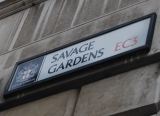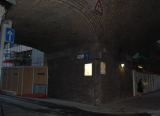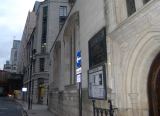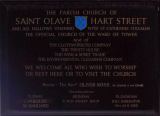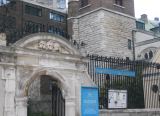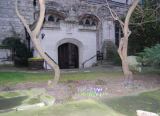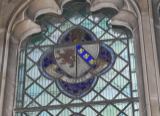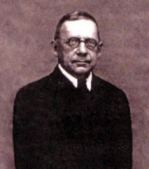 |
A
trip to London is an opportunity to visit places connected
with the Morgan family, the ancestors of Father Francis Morgan,
the guardian of J.R.R. Tolkien. This family left its mark in
the city, as equally noteworthy are the works of some of the
relatives of Father Francis. |
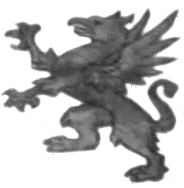 |
| Morgan Coat of Arms |
Until 1840, the headquarters of the firm were at 13 Savage Gardens, near to the Tower of London. However during this period its name changed (adding the new partners). Thus, retained the name of Langston & Dixon until 1800 but from then until 1810 was Dixon, Brett & Morgan (indicating the inclusion of Aaron Morgan as an associate with one James Brett). Since then and until 1835 was renamed Dixon, Morgan & Co and from 1835 to 1840 was known as Morgan & Saunders & Co.
| Maria Morgan went to India with his husband where he witnessed the local customs which she collected in a memoir that has been used as a source in several historical works. |
Thomas Morgan was, as indicated above, the heir of Aaron Morgan in the field of business. Married with Elizabeth Bonney in April 1818, his role in the history of the family business is also very important since his management coincided with the departure of Dixon, as well as with a diversification process that involved the direct participation of his sons.
This nineteenth-century
map indicates the location of Savage Gardens and
surrounding areas near the London docks. |
 |
| At present the layout of the streets has changed a bit. |
At this point it is interesting remark some personal aspects in the life of Aaron Morgan, extended to his descendants, especially his link with two boroughs of London.
The first is the area of the Tower of London, where his firm were established. The other one, on the other side of the Thames, is Southwark, precisely Dulwich where his home was.
Also, it is important emphasize his relationship with the parishes of both areas, especially St. Olave and St. Saviour (now Southwark Cathedral).
St. Olave's Church is a small church near Savage Gardens where several religious events of the Morgan family happened, especially the marriages of Jane Elizabeth, Edith and Thomas Morgan.
In this case, there is a window in which appear the names and symbols of the Morgan family (a griffin segreant) and Bonney (three fleurs-de-lis), commemorating their wedding.
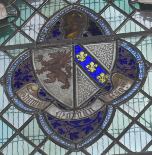
In addition, this church is "the official church of the ward of the tower" but also of the wine and spirit trade.
 |
However Aaron Morgan's link with St. Saviour (former Parish of St. Mary Overy and since 1905 Southwark Cathedral) is more significant.
Aaron Morgan wrote with Matthew Concanen the "History and Antiquities of the Parish of St. Saviour's" in 1795 which describes the history of both the neighborhood and the church.
In fact he was buried there beside his wife who died several years before him. His participation in the book quoted above was probably a merit in order to this distinction. There is a monument consisting of a neat tablet with ornamental pilasters and a bust of him made by sculptor Thomas Cooke, inscribed:
 |
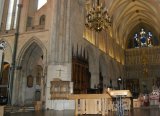 |
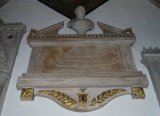 |
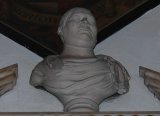 |
 |
| Aaron Morgan is buried in the Southwark Cathedral, surely the main Anglican church that lies on the south bank of the River Thames. | |||
 |
Indeed, Aaron Morgan died in Dulwich on October 13, 1818, only few months after the marriage of his son Thomas (April 24) who was already one of the heads of the firm and who was appointed by his father as sole executor of his Will.
Thomas took the leadership on the firm and kept it for several decades in the nineteenth century. The firm began to distribute a wide range of alcoholic products, in addition to the Port, such as Sherry, Red wine, Claret, Madeira wine, etc... This fact implied the development of an extensive network commercial and an intricate system of international commercial relations.
In 1840 the company changed its name again to Thomas Morgan & Co and its headquarters moved to 11 Mark Lane, very near to Savage Gardens. However in 1845, under the name Morgan Jun. & Ridge, they came back to this street, specifically to the number 24 and remained there until 1865.
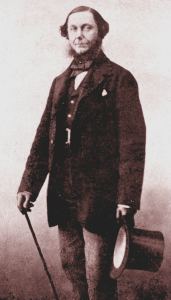 |
||
Francis
Morgan (Sr.) around 1850. Osborne Archive. Spain. |
||
Allen and Morgan Co. was established in 1841 in partnership with John Allen (a leading liquor businessman settled in Portugal). The firm established a headquarter in El Puerto de Santa Maria (Spain) in the "Shire of the Sherry" and as representative Francis Morgan moved to Spain.
With Thomas Morgan and later with Thomas Jr. managing the business from London, Francis Morgan was responsible of creating in Spain the network of production and exportation needed to avoid intermediaries. Although Allen and Morgan was in liquidation in 1847 (to Morgan Jr & Ridge), Francis Morgan stayed in Spain and became a crucial link to the family business, but above all he established his own ties.
He married a native of the town, although with English ancestors for her father's side. She, Maria Manuela Osborne, was the eldest daughter of the owner of one of the biggest houses in the Sherry trade (Duff-Gordon, now Osborne). She was Roman Catholic and she educated in this faith to all his children. The youngest son, born in 1857 and also named Francis, was Father Francis Morgan (guardian of J.R.R. Tolkien).
In addition, the trajectories of Thomas Jr. and Aaron Augustus are also interesting. Thomas was born in 1820. Although deeply implied with the business, he had a deep passion for archeology a became Treasurer of the British Archaeological Association. He wrote several articles and the book "Romano-British mosaic pavements; a history of their discovery, and a record and interpretation of their designs" Many of his descendants settled in Portugal, as did his son Albert.
Aaron Augustus was also an intellectually curious person. He wrote two books, "The mind of Shakspeare", on this author, and he published too, by subscription, a translation of "Ecclesiastes". Indeed, the list of subscribers gives us an idea of the Morgan family relationships.
 |
[...] More is available in "J.R.R. Tolkien's Spanish Connection".
© The text, genealogical tree and the images of London are Copyright by the author.
